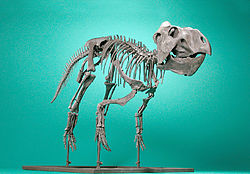Ceratopsia

The Ceratopsia are the horned dinosaurs of the order Ornithischia. Triceratops is the best-known, and one of the largest. They are a group of herbivorous, beaked dinosaurs. They thrived in what is now North America and Asia, during the Cretaceous period.

Ancestral forms of this group lived earlier, in the Jurassic. Early members, such as Psittacosaurus, were small and bipedal.
Later members, including Centrosaurus and Triceratops, became very large quadrupeds. They developed elaborate facial horns and a neck frill. The frill served mainly to protect the vulnerable neck from bipedal predators like Tyrannosaurus, who attacked from above.
The frill was no doubt also used in display, thermoregulation, the attachment of large neck and chewing muscles or some combination of those.
Ceratopsians ranged in size from 1 meter (3 ft) and 23 kilograms (50 lb) to over 9 meters (30 ft) and 5,400 kg (12,000 lb).
Triceratops is by far the best-known ceratopsian to the general public.[1]
Ceratopsia Media
Centrosaurus, with large nasal horn and bony processes over the front of the frill. Museum of Victoria.
Agathaumas was the first recognized genus of ceratopsian.
Psittacosaurus, an early ceratopsian
Prenoceratops, a leptoceratopsid
Protoceratops, a protoceratopsid
Styracosaurus, a centrosaurine ceratopsid
Triceratops, a chasmosaurinae ceratopsid and one of the last and largest ceratopsians
Ceratopsid skulls at the Natural History Museum of Utah
References
- ↑ Dodson P. 1996. The horned dinosaurs. Princeton: Princeton University Press.











